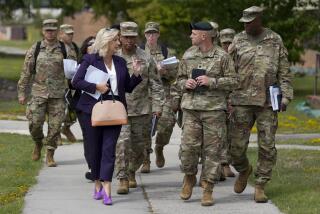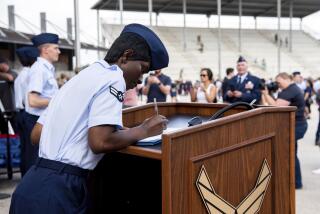Navy to Stop Recruiting Filipino Nationals : Defense: The end of the military base agreement with the Philippines will terminate the nearly century-old program.
The Navy says it will stop recruiting Filipino nationals Dec. 31, ending a unique program that each year afforded about 400 of the brightest young men in the Philippines an opportunity to escape grinding poverty by joining the service.
Recruiting will cease both because the military base agreement with the Philippines is ending and because U.S. armed forces are scaling down, said Navy spokeswoman Lt. Deborah Carson in an interview Wednesday from Washington.
Tens of thousands of Filipinos have served in the Navy since the end of the Spanish-American War, when the Philippines became a U.S. colony. Filipino sailors have fought in every conflict involving the U.S. armed forces since 1900.
Although Navy officials have acknowledged the role of Filipino sailors since the turn of the century, Carson said the recruitment of them was formalized in 1947, when the United States and the Philippines signed the military bases agreement.
The agreement, which allowed the United States to maintain military bases in the Philippines, will end in December.
About 34,620 Filipinos enlisted in the Navy between 1952 and 1990, Carson said, the only period for which figures are available. Over the past decade, the Navy has recruited about 400 Filipinos--all men--each year.
Filipinos were the only foreign nationals allowed to enlist in the U.S. armed forces without first immigrating to this country. And the Navy was the only military branch they could join.
Competition for the 400 slots was fierce. Carson said the Navy received as many as 100,000 applicants--250 applicants per slot--each year. After weeding out those viewed as unqualified to enlist, the Navy tested about a quarter of the applicants and picked the top 400.
Machinist Dan Galang, who enlisted in 1981, told The Times in 1986 that he was among 24,000 men who were tested by the Navy in 1981. Of the 600 men in his group who took the test, only 11 were picked to enlist, he said.
Carson said the Filipinos’ retention rate is higher than for U.S. citizens. Fewer than 5% of the Filipino sailors failed to re-enlist after their first enlistment, which is six years, she said. By comparison, about 56% of the U.S. citizen enlistees fail to re-enlist after their first enlistment, which can be either four or six years.
“Typically, they are described as very good sailors who are dedicated to their jobs,” Carson said.
Although only 82.5% of the Navy’s enlisted personnel have a high school diploma, each of the Filipino sailors is a high school graduate and the majority are either college graduates or have attended college, she said.
San Diego attorney Jesse Quinsaat, whose father, Jose Quinsaat, enlisted in the Philippines and retired after 28 years in the Navy, said the end of the enlistment program is viewed by some Filipinos as breaking the last vestige of colonialism.
“But for thousands of Filipinos like my father, joining the Navy was a great economic opportunity,” Quinsaat said. “They also had a sincere belief that the United States was like a mother country to the Philippines. Joining the Navy was the fulfillment of a lifetime dream for many to serve the United States.”
In addition to the economic rewards, the enlistment slots were also coveted because they represented the first step toward eventual U.S. citizenship for the sailors. U.S. immigration laws allow Filipinos and permanent U.S. residents serving on active duty in the military during a declared conflict to apply for naturalization, if Congress and the President declare an official period of hostilities.
Between 1917, when America entered World War I, and continuing sporadically through Oct. 15, 1978, when Congress declared the Vietnam War officially over, about 30,000 Filipino sailors became citizens by virtue of the wars that involved the United States.
However, no Filipinos have been eligible for automatic naturalization since the end of the Vietnam War, because Congress and the President did not declare an official period of hostilities during the armed conflicts in Grenada in 1983, Panama in 1989 and the Persian Gulf in 1991.
After the Persian Gulf War, there was widespread support in Congress for a bill that extended citizenship to foreign nationals who served honorably and on active duty during the conflict.
The new law, passed last year, extends citizenship to Filipinos who have served honorably for at least 12 years, or who have served a six-year enlistment and re-enlist for six more years, Carson said.
“The suspension of the (recruitment) program does not affect the approximately 3,400 citizens of the Philippines who are currently serving on active duty . . . or those who have already been accepted to enter the Navy through September,” Carson said.
Quinsaat said the suspension of the program “means that many people in the Philippines with college degrees and who can’t get jobs will no longer have the opportunity to join the Navy.”
“It was a foregone conclusion that the (enlistment) program would end when the bases agreement ended,” he said. “Many Filipinos see the end of both as also the end of a colonial era. . . . At one time they (enlistment and base agreements) went hand in hand with the close relationship between the U.S. and the Philippines. But the end of the enlistment program signifies the end of all that.”
More to Read
Sign up for Essential California
The most important California stories and recommendations in your inbox every morning.
You may occasionally receive promotional content from the Los Angeles Times.










